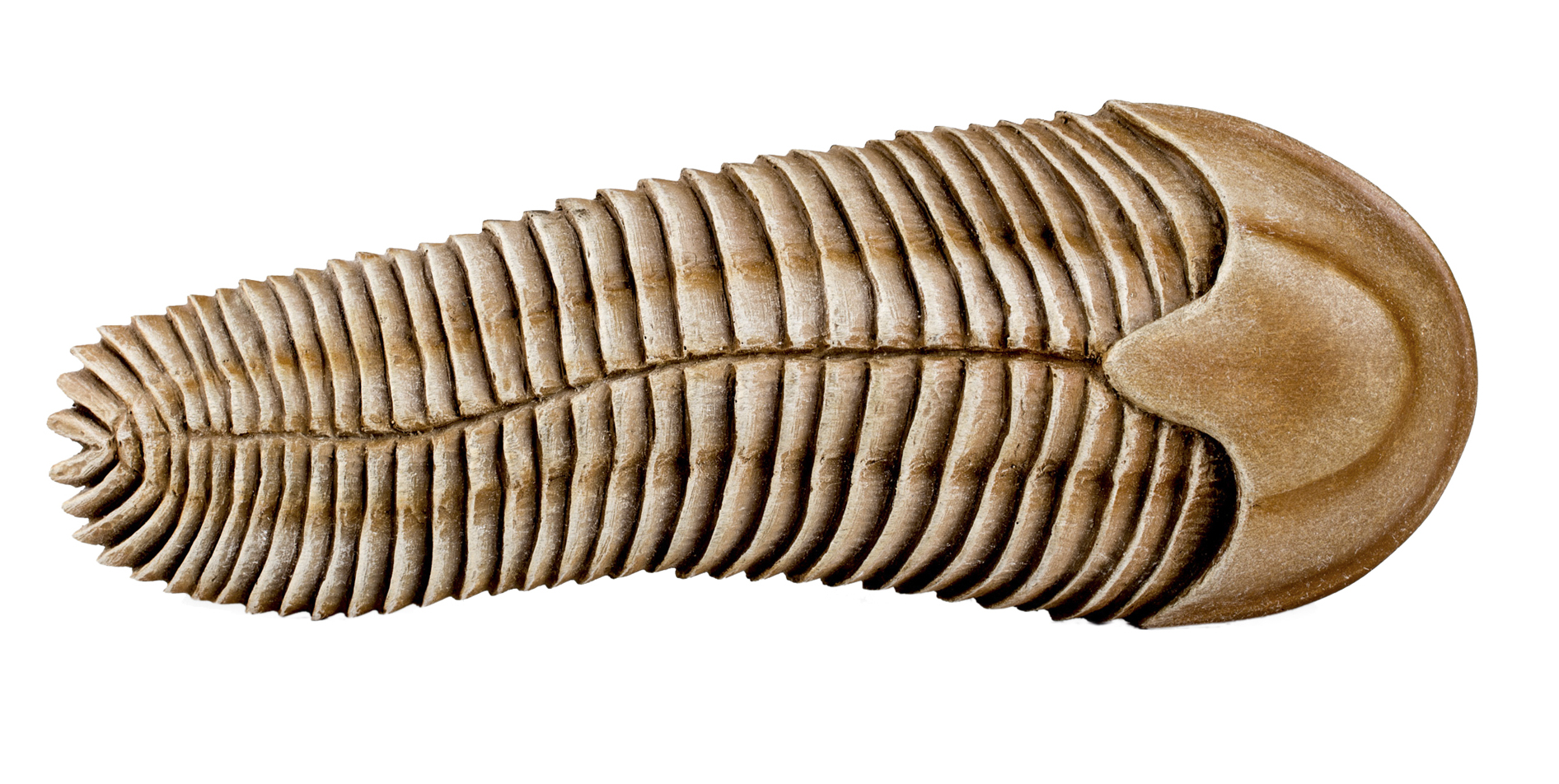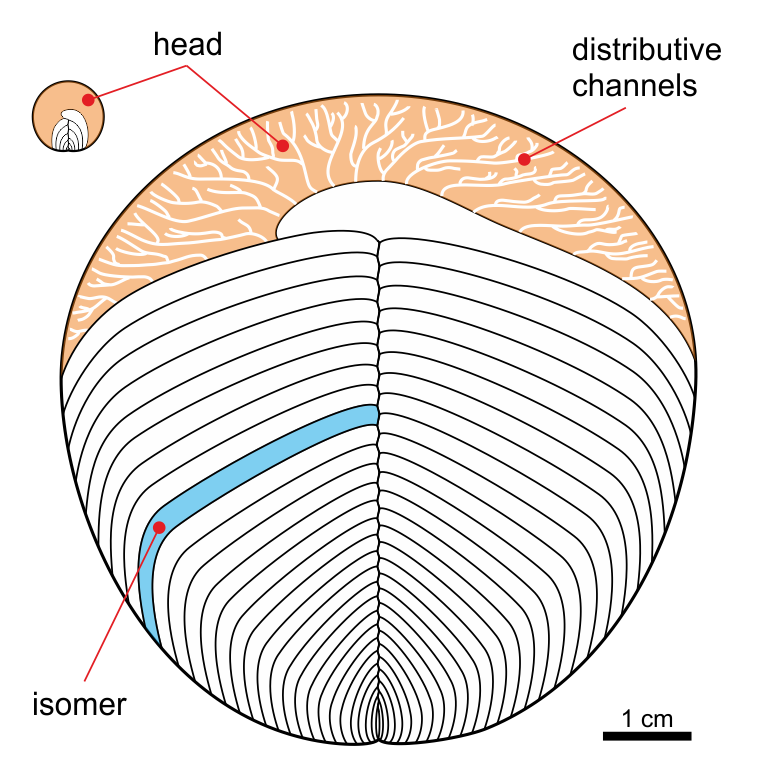|
Praecambridium Sigillum
''Praecambridium sigillum'' is an extinct organism that superficially resembles a segmented trilobite-like arthropod. It was originally described as being a trilobite-like arthropod, though the majority of experts now place it within the Proarticulata as a close relative of the much larger ''Yorgia''. It is from the Late Ediacaran deposit of Ediacara Hills, Australia, about 555 million years ago. On average, ''P. sigillum'' had at least 5 pairs of segments, with each unit becoming progressively larger as they approach the cephalon-like head. Etymology The generic name is a compound word, with the Latin prefix ''prae'' "before" and a reference to the Cambrian mollusc genus '' Cambridium'', in reference to how the appearance of the various segments are reminiscent of the muscle-scars on the inner surface of the shells of '' Cambridium''. The specific name is from Latin ''sigillum'' "a sigil". Classification and interpretations Originally, Runnegar and M.A. Fedokin (1992) suggested ... [...More Info...] [...Related Items...] OR: [Wikipedia] [Google] [Baidu] |
Sprigginidae
Sprigginidae is an extinct family of cephalozoans characterized by having a greater number of isomers than its sister taxon, Yorgiidae. They lived approximately 635 million years ago, in the Ediacaran period. Distribution Fossils are found within the Ediacaran sediments of South Australia. Taxonomy Sprigginidae presents 4 genera: *†''Spriggina'' (type genus). *†''Marywadea'' *†''Cyanorus'' *†''Praecambridium'', sometimes included into Yorgiidae. Gallery Spriggina_flounensi_C.jpg , ''Spriggina floundersi'' Cyanorus_singularis.jpg , ''Cyanorus singularis'' Praecambridium_sigillum.jpg , ''Praecambridium sigillum'' See also *Cephalozoa *Yorgiidae Yorgiidae is an extinct family of cephalozoans, which lived 635 million years ago. They were filter fed. Description Like most proarticulates, they present semi-bilateral symmetry. They had a discoid appearance, with the body segmented by isome ... References Ediacaran life {{Ediacaran-stub ... [...More Info...] [...Related Items...] OR: [Wikipedia] [Google] [Baidu] |
Ediacaran
The Ediacaran Period ( ) is a geological period that spans 96 million years from the end of the Cryogenian Period 635 million years ago (Mya), to the beginning of the Cambrian Period 538.8 Mya. It marks the end of the Proterozoic Eon, and the beginning of the Phanerozoic Eon. It is named after the Ediacara Hills of South Australia. The Ediacaran Period's status as an official geological period was ratified in 2004 by the International Union of Geological Sciences (IUGS), making it the first new geological period declared in 120 years. Although the period takes its name from the Ediacara Hills where geologist Reg Sprigg first discovered fossils of the eponymous Ediacaran biota in 1946, the type section is located in the bed of the Enorama Creek within Brachina Gorge in the Flinders Ranges of South Australia, at . The Ediacaran marks the first appearance of widespread multicellular fauna following the end of Snowball Earth glaciation events, the so-called Ediacaran biota, ... [...More Info...] [...Related Items...] OR: [Wikipedia] [Google] [Baidu] |
Spriggina
''Spriggina'' is a genus of early bilaterian animals whose relationship to living animals is unclear. Fossils of ''Spriggina'' are known from the late Ediacaran period in what is now South Australia. ''Spriggina floundersi'' is the official fossil emblem of South Australia. It has been found nowhere else. The organism reached about in length and may have been predatory. Its bottom was covered with two rows of tough interlocking plates, while one row covered its top; its front few segments fused to form a "head." ''Spriggina'' affinity is currently unknown; it has been variously classified as an annelid worm, a rangeomorph-like frond, a variant of ''Charniodiscus'', a proarticulatan, or an arthropod perhaps related to the trilobites, or even an extinct phylum. Lack of known segmented legs or limbs, and glide reflection instead of symmetric segments, suggest an arthropod classification is unlikely despite some superficial resemblance. The genus ''Spriggina'' may have originally co ... [...More Info...] [...Related Items...] OR: [Wikipedia] [Google] [Baidu] |
Yorgiidae
Yorgiidae is an extinct family of cephalozoans, which lived 635 million years ago. They were filter fed. Description Like most proarticulates, they present semi-bilateral symmetry. They had a discoid appearance, with the body segmented by isomers. Distribution Ediacaran of Russian Federation and South Australia. Gallery Archaeaspinus_fedonkini.jpg , ''Archaeaspinus fedonkini'' Photo_of_"Archaeaspinus_fedonkini"_fossil_Ivantsov_2007.png , ''Other fossil of Archaeaspinus fedonkini'' Yorgia_trace.jpg , ''Epibaion waggoneri, possible ichnofossil of Yorgia waggoneri'' See also * Cephalozoa References Cephalozoa Yorgiidae Ediacaran life Fossils of Russia {{Ediacaran-stub ... [...More Info...] [...Related Items...] OR: [Wikipedia] [Google] [Baidu] |
Cephalozoa
Cephalozoa are an extinct class of primitive segmented marine organisms within the Phylum Proarticulata from the Ediacaran period. They possessed bilateral symmetry and were characterized by a thin, rounded body. Description Unlike the other classes of proarticulates, the segmentation of the body is not complete and shows a "head" with fine distribution channels. Some species of the Yorgiidae family also show some asymmetry.Ivantsov, A. Y. (2004"Vendian Animals in the Phylum Proarticulata" The Rise and Fall of the Vendian Biota. IGSP Project 493. Abstracts. Prato, Italy, . They were discovered in Russia near the White Sea in the Arkhangelsk region, where they lived during the Ediacaran, approximately 635 to 540 Ma (millions of years ago). Taxonomy Cephalozoa includes the families Yorgiidae and Sprigginidae: Yorgiidae *† ''Archaeaspinus'' Ivantsov, 2007 (synonym of ''Archaeaspis'') **† ''Archaeaspinus fedonkini'' Ivantsov, 2001 *† ''Yorgia'' Ivantsov, 1999 **† ''Yorgi ... [...More Info...] [...Related Items...] OR: [Wikipedia] [Google] [Baidu] |
List Of Ediacaran Genera ...
This is a list of all described Ediacaran genera, including the Ediacaran biota. It contains 227 genera. References {{reflist, 30em * Ediacaran The Ediacaran Period ( ) is a geological period that spans 96 million years from the end of the Cryogenian Period 635 million years ago (Mya), to the beginning of the Cambrian Period 538.8 Mya. It marks the end of the Proterozoic Eon, and th ... [...More Info...] [...Related Items...] OR: [Wikipedia] [Google] [Baidu] |
Agnostida
Agnostida is an order of arthropod which have classically been seen as a group of highly modified trilobites, though some recent research has doubted this placement. Regardless, they appear to be close relatives as part of the Artiopoda. They are present in the Lower Cambrian fossil record along with trilobites from the Redlichiida, Corynexochida, and Ptychopariida orders, and were highly diverse throughout the Cambrian. Agnostidan diversity severely declined during the Cambrian-Ordovician transition, and the last agnostidans went extinct in the Late Ordovician. Systematics The Agnostida are divided into two suborders — Agnostina and Eodiscina — which are then subdivided into a number of families. As a group, agnostids are isopygous, meaning their pygidium is similar in size and shape to their cephalon. Most agnostid species were eyeless. The systematic position of the order Agnostida within the class Trilobita remains uncertain, and there has been continuing deb ... [...More Info...] [...Related Items...] OR: [Wikipedia] [Google] [Baidu] |
Annelid
The annelids (Annelida , from Latin ', "little ring"), also known as the segmented worms, are a large phylum, with over 22,000 extant species including ragworms, earthworms, and leeches. The species exist in and have adapted to various ecologies – some in marine environments as distinct as tidal zones and hydrothermal vents, others in fresh water, and yet others in moist terrestrial environments. The Annelids are bilaterally symmetrical, triploblastic, coelomate, invertebrate organisms. They also have parapodia for locomotion. Most textbooks still use the traditional division into polychaetes (almost all marine), oligochaetes (which include earthworms) and leech-like species. Cladistic research since 1997 has radically changed this scheme, viewing leeches as a sub-group of oligochaetes and oligochaetes as a sub-group of polychaetes. In addition, the Pogonophora, Echiura and Sipuncula, previously regarded as separate phyla, are now regarded as sub-groups of polycha ... [...More Info...] [...Related Items...] OR: [Wikipedia] [Google] [Baidu] |
Arthropod
Arthropods (, (gen. ποδός)) are invertebrate animals with an exoskeleton, a Segmentation (biology), segmented body, and paired jointed appendages. Arthropods form the phylum Arthropoda. They are distinguished by their jointed limbs and Arthropod cuticle, cuticle made of chitin, often Mineralization (biology), mineralised with calcium carbonate. The arthropod body plan consists of segments, each with a pair of appendages. Arthropods are bilaterally symmetrical and their body possesses an exoskeleton, external skeleton. In order to keep growing, they must go through stages of moulting, a process by which they shed their exoskeleton to reveal a new one. Some species have wings. They are an extremely diverse group, with up to 10 million species. The haemocoel, an arthropod's internal cavity, through which its haemolymph – analogue of blood – circulates, accommodates its interior Organ (anatomy), organs; it has an open circulatory system. Like their exteriors, the internal or ... [...More Info...] [...Related Items...] OR: [Wikipedia] [Google] [Baidu] |
Dickinsonia
''Dickinsonia'' is an extinct genus of basal animal that lived during the late Ediacaran period in what is now Australia, China, Russia and Ukraine. The individual ''Dickinsonia'' typically resembles a bilaterally symmetrical ribbed oval. Its affinities are presently unknown; its mode of growth is consistent with a stem-group bilaterian affinity, though some have suggested that it belongs to the fungi, or even an "extinct kingdom". It lived during the late Ediacaran (part of Precambrian). The discovery of cholesterol molecules in fossils of ''Dickinsonia'' lends support to the idea that ''Dickinsonia'' was an animal. Description ''Dickinsonia'' fossils are known only in the form of imprints and casts in sandstone beds. The specimens found range from a few millimetres to about in length, and from a fraction of a millimetre to a few millimetres thick. They are nearly bilaterally symmetric, segmented, round or oval in outline, slightly expanded to one end (i.e. egg-shaped out ... [...More Info...] [...Related Items...] OR: [Wikipedia] [Google] [Baidu] |
Chelicerate
The subphylum Chelicerata (from New Latin, , ) constitutes one of the major subdivisions of the phylum Arthropoda. It contains the sea spiders, horseshoe crabs, and arachnids (including harvestmen, scorpions, spiders, solifuges, ticks, and mites, among many others), as well as a number of extinct lineages, such as the eurypterids (sea scorpions) and chasmataspidids. The Chelicerata originated as marine animals in the Middle Cambrian period; the first confirmed chelicerate fossils, belonging to '' Sanctacaris'', date from 508 million years ago. The surviving marine species include the four species of xiphosurans (horseshoe crabs), and possibly the 1,300 species of pycnogonids (sea spiders), if the latter are indeed chelicerates. On the other hand, there are over 77,000 well-identified species of air-breathing chelicerates, and there may be about 500,000 unidentified species. Like all arthropods, chelicerates have segmented bodies with jointed limbs, all covered ... [...More Info...] [...Related Items...] OR: [Wikipedia] [Google] [Baidu] |
Trilobite
Trilobites (; meaning "three lobes") are extinct marine arthropods that form the class Trilobita. Trilobites form one of the earliest-known groups of arthropods. The first appearance of trilobites in the fossil record defines the base of the Atdabanian stage of the Early Cambrian period () and they flourished throughout the lower Paleozoic before slipping into a long decline, when, during the Devonian, all trilobite orders except the Proetida died out. The last extant trilobites finally disappeared in the mass extinction at the end of the Permian about 252 million years ago. Trilobites were among the most successful of all early animals, existing in oceans for almost 270 million years, with over 22,000 species having been described. By the time trilobites first appeared in the fossil record, they were already highly diversified and geographically dispersed. Because trilobites had wide diversity and an easily fossilized exoskeleton, they left an extensive fossil record. The stu ... [...More Info...] [...Related Items...] OR: [Wikipedia] [Google] [Baidu] |







.jpg)